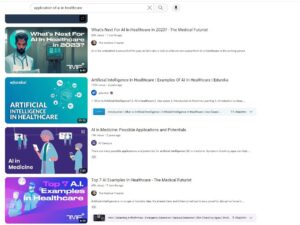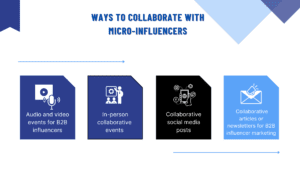This article was originally published in the Elevate Your Marketing newsletter and has been repurposed and republished here with the author’s permission. Here is the link to the original article.
Influencers are big in the B2C space. Instagram and YouTube are flooded with creators endorsing products related (and sometimes unrelated) to their niche. But influencer marketing is one of the least (if not the least) explored marketing tactics in the B2B space.
But to many, influencer marketing is just about popular creators promoting a product directly through their YouTube channel or social media handle.
However, leveraging micro-influencers in B2B can go much beyond the traditional boundaries of influencer marketing. In this article, I share a unique perspective on this with you, which I call lean B2B influencer marketing.
As we dive deep into the topic, we will learn the various tactics and tools you can use to improve the visibility and reach of your business using lean B2B influencer marketing (or micro-influencer marketing).
Who are micro-influencers?
I don’t know if there is a standard definition for micro-influencers. To me, they are creators who are not as big as the popular names in a niche but are in the early stages of their growth in terms of building an audience.
For example, you wouldn’t call Neil Patel a micro-influencer since he is already a big name in the marketing world. But I consider Sanjana Murali to be a micro-influencer (that’s the reason why I did a podcast with her recently. Check it out here).
She actively creates high-quality content on LinkedIn. She also has a YouTube channel called All About B2B Marketing where she interviews experts in the B2B marketing space.
Like her, there are many upcoming creators who don’t have a very large following yet but are good at their craft. Micro-influencing involves leveraging such people to increase your business’s reach.
How do you find B2B micro-influencers?
Finding an influencer is easy in many ways. But micro-influencers, on the other hand, are lesser known, and hence not that easy to find.
The most obvious method to find a micro-influencer is to use the native search option given by the respective platform.
Let us take YouTube for example. Imagine you are a business selling data analytics and AI solutions to healthcare companies. You can do a search on YouTube using a keyword like ‘application of AI in healthcare’ to find videos on the topic.
These are the top organic results you get (this could change based on the location you are searching from):

You will primarily find three types of content creators:
- Companies in the healthcare space
- Individuals
- Media companies or industry alliances in the domain
As you can guess, you need to ignore other companies (who could be your competitors) and focus on individual creators or media companies.
Now, how do you filter out micro-influencers from the list of creators?
That’s a little tricky. Here are a few suggestions:
If you are looking for creators in a niche space, the top ones themselves might not have a great reach. So you can consider them micro-influencers. On the other hand, if you are going after a very generic and mature category like IT services for example, you might want to scroll past the top results and focus on creators who are not that big.
Similarly, on LinkedIn, you can find micro-influencers using hashtags or keyword searches. You can filter posts or people and check if they could potentially be used for a micro-influencer campaign. This will require a bit of manual work since most search results might not be relevant.
The same is the case with finding bloggers. You can Google using relevant keywords in your niche to find bloggers who might be interested in collaborations.
However, all these methods are cumbersome and time-consuming. Is there a quicker way to find B2B micro-influencers? Of course, there is.
The way to go about it is to use influencer marketing tools. One of my favorites is SparkToro. It is an audience research tool that will help you find websites, YouTube channels, social media profiles, podcasts, etc., that discuss a topic of your interest.
If you want to take your influencer marketing game to the next level, you can go with a specialized influencer marketing tool like Upfluence. Upfluence helps you find influencers and easily manage influencer marketing campaigns. As I mentioned before, the key is to find upcoming influencers who create high-quality content and have a relevant audience to your niche.
The next question is, once you narrow down the list of creators, how do you reach out to them to check if they are interested in collaborating with you?
For this, you can use LinkedIn or a tool like RocketReach (or any email lookup tool you prefer). Using platforms like Upfluence is an easier method to manage influencer communications and campaigns in a single place.
While you try all these methods, don’t forget to tap into your own network to find micro-influencers. Even if you don’t have them in your direct contacts, someone in your network might know micro-influencers in your space.
How should you collaborate with B2B micro-influencers?
This is where leveraging micro-influencers stands out from traditional influencer marketing campaigns. While you can still go the traditional route by finding influencers and paying them to endorse your products or services in their content, that’s not where the untapped potential lies.
The unexplored opportunity in B2B influencer marketing is in organic partnerships.
What do I mean by organic partnerships?
These are collaborations where you are exchanging something of value instead of doing a paid engagement. The value can be either each other’s reach or a unique opportunity both parties can bring to the table.
For instance, I am in the business of selling marketing services to B2B companies. One of the ways in which I reach my target audience is by appearing on podcasts as a guest or expert sharing my thoughts on a topic related to B2B marketing (unconventional, isn’t it?).
For example, I recently appeared on a podcast called Connecting and Stuff, hosted by Rashmita Behera, where I discussed my views on the state of marketing in B2B startups. Here is an excerpt from the podcast:
By appearing on Rashmita’s podcast, I benefit from the reach it gets. In return, I also promote the podcast extensively on LinkedIn and Skalegrow’s YouTube channel. It’s a win-win situation for both. And the more interesting part? It was all free. We simply wanted to tap into each other’s audience.
There are many more ways in which you can collaborate with micro-influencers like this. Let’s explore them in this section:

Ways to collaborate with micro- influencers
1. Audio and video events for B2B influencers
Online events are a great way to collaborate with micro-influencers. LinkedIn gives you the opportunity to host live audio as well as video events. You can do them in different formats:
- You become the host with the micro-influencer sharing his/her opinion on the topic.
- The micro-influencer hosting the show while you share your thoughts as an expert.
For example, check out this recent audio event I did with Amitabh Ramani, where I was the host and Amitabh was the domain expert sharing his views on ABM. With this event, we were able to leverage our combined reach.
In a similar fashion, you can collaborate with micro-influencers in the form of LinkedIn events, YouTube interviews, webinars, etc.
2. In-person collaborative events
With COVID out of the way now, people are eager to attend in-person events more than ever. But how can these in-person events be opportunities to leverage micro-influencers?
Firstly, since these are in-person events, you need to find micro-influencers based in the same location as yours. Or at least, you should travel to the location where you are planning the event in.
Choice of the city is important here. Not every city invites the same level of participation from business owners and professionals. For example, Bangalore, where I am based, offers a lot of opportunities for you to attend events hosted by others, and attracts a decent audience when you host one.
Now, here are the ways in which you can make use of in-person events:
- Look for events hosted by others that your potential buyers would attend. Go to such events with the micro-influencer. Together you might be able to grab more eyeballs than you attending it alone.
- Host your own events for people in your target audience.
In the case of the former, the obvious question is, how do you find these events? One of the ways is to use the Meetup app. Another way is to simply ask people in your network who would know communities that host events in your niche. A simple google search would also work.
To host your own events, you can find an event-hosting company to help you. To attract participation in events like these, you can use the Meetup app itself or use your own personal/business’s reach on social media platforms (how to do it is a different topic in itself).
Since you are collaborating with a micro-influencer, you get some extra reach. The most important criterion here is that the micro-influencer too should derive some value from the event, especially if he/she is collaborating with you for free.
3. Collaborative social media posts
This can be as simple as you tagging the micro-influencer to having him/her contribute to your post content (or vice versa).
For example, look at this post where I consolidated thoughts from 3 B2B marketing leaders on the topic ‘top demand gen tactics for 2023’.
If you are also doing collaborative videos (like we discussed in technique #1), you can cut the video into smaller snippets and promote them on LinkedIn by tagging the micro-influencer. Check out this post for example where I promoted a snippet from my podcast with Rashmita by tagging her.
You can think about more creative ways of doing collaborative posts. But the idea is to increase your reach through the power of collaboration.
4. Collaborative articles or newsletters for B2B influencer marketing
This is very similar to collaborative social media posts, only that these require more time and effort. If you or the micro-influencer have a blog or a newsletter, you can plan to co-author an article on a topic relevant to both your audiences. As in the case of the other methods, you benefit from the combined reach.
Let us take my LinkedIn newsletter – Elevate Your Marketing– for example. If you are a B2B marketing leader looking to build a personal brand, I will be more than happy to have you contribute your thoughts to one of my newsletter articles.
Since each article gets an average of 600 views, you benefit from its reach. In return, I get to include expert thoughts from a B2B marketing practitioner in my article, which in turn improves the overall quality of the content.
Final words about B2B influencer marketing
If you have read this far, you might have felt that micro-influencer marketing tactics are so simple and commonsensical. Despite that, it remains one of the most underutilized marketing channels. Part of the reason is the fact that they give you results only in the long term. But that’s true for most marketing activities you do – from SEO-led content to video marketing and podcasting.
So if you can set aside some time for this, you will see your results compound over time. In addition to what I discussed in this article, put some thought into the other ways in which you can collaborate with micro-influencers.
About the author

Naseef KPO is the Founder and CEO of Skalegrow. He comes with rich experience across multiple areas of B2B marketing including content marketing, demand generation, SEO, account-based marketing, marketing analytics, revenue attribution, marketing technology, etc. He writes thought-provoking and relevant articles on The Skalegrow Blog and his weekly LinkedIn newsletter Elevate Your Marketing.
Prior to starting Skalegrow, Naseef led large marketing teams in multi-million dollar B2B organizations where he made significant contributions to the topline growth of the business. He has also appeared on numerous podcasts where he shared his thoughts on trending marketing topics such as the application of AI in marketing, startup marketing, ABM, and B2B content marketing, just to name a few. Being the founder of Skalegrow, he is currently focusing on helping its clients stay ahead of their competition by using innovative yet practical marketing tactics.
You can connect with Naseef KPO on LinkedIn.


